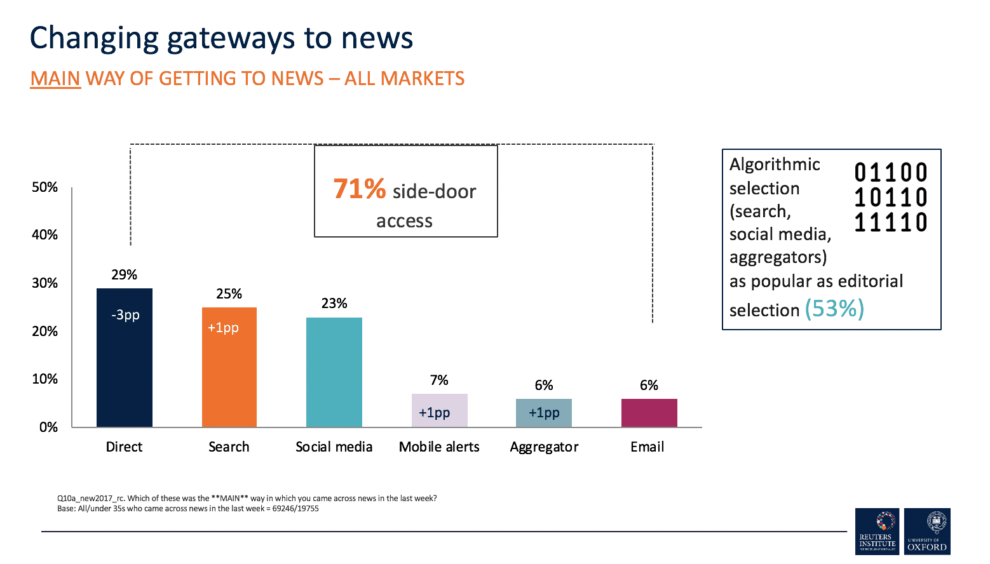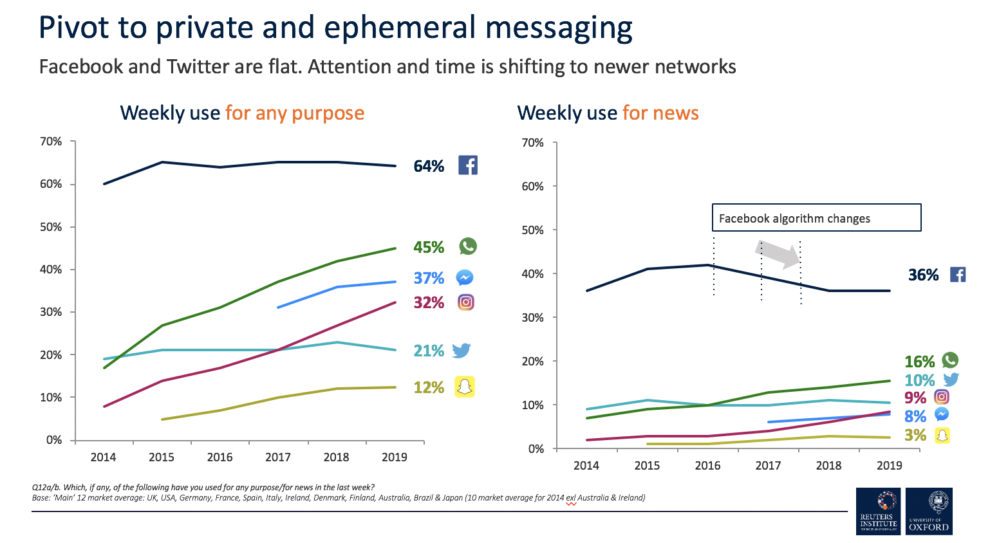Blog
GEN Summit 2019: monetising audio, building direct relationships, and emerging tech
Over three days in sunny Athens, the Global Editors Network gathered a large group of innovators in the media industry, coming from the commercial, editorial, and technology spheres. With this diverse group at GEN Summit, three main conversations emerged: determining how we can monetise audio efforts, the importance of building direct relationships with readers, and looking ahead to emerging tech and formats.
Monetisation of audio
A big question in the industry this year has been on monetising audio, one of the reasons why we started the series “Business of Audio“. We heard it asked in a few Q&A sessions during GEN as well. In the session “Is the pivot to podcast sustainable and how to go beyond the Anglosphere?”, we answered just this. Moderated by yours truly, we were joined on stage by Siobhan McHugh of University of Wollongong, Jade Wang Lu of China Plus, and Mark Pagán of PRX.
“Audio is not just video without pictures” says Siobhan McHugh. She urges journalists to convey emotion and make podcasts personal – even the news ones. #GENSummit pic.twitter.com/KQH8Q44jnV
— Niko Efstathiou (@NikoEfst) June 15, 2019
At first we had to respond to the elephant in the room, have we reached “peak podcast”? Do we risk just another failed pivot, similar to video, as we invest more in audio? The panelists all agreed that there is no bubble for podcasts now; we’re still at a burgeoning stage of what can happen, both in terms of content but also technologically. Furthermore, the US is still very dominant within podcasting, whether that’s because of differences in what’s considered a podcast (such as in China, only Apple uses the term) or unequal distribution of technology for the creation of podcasts.
Then we moved into the topic of monetisation of podcasts, and how we can go beyond advertisements. We began by responding to some insights from Nic Newman of Reuters Institute, who we had heard from earlier in the Summit. He believes that while the monetisation model for podcasts is still just emerging today, it is important that we do not only look at making money right now, but in the long term as well. For example, The Guardian uses audio to both build loyalty and offer sampling of its journalism. Then for the real blockbusters, publishers can even explore paid models. But it is this loyalty aspect of audio that is sometimes overlooked
As a subscription publisher, you need to be looking at how you build loyalty over time. Podcasts are amazing for this, listeners are getting to know the brand in real time. People aren’t spending enough time with digital, to build a subscription model you need time with the content.
Nic Newman, Reuters Institute
Direct relationships
It’s no secret that publishers need to be building direct relationships with their readers; we’ve learned this from the scare after Facebook changed its algorithm to deprioritise news in the “newsfeed” or when many publishers decided not to make their content available on Apple News+. But in a session on the newly released “Digital News Report“, we heard that it is the publishers who are more able to build direct relationships with their readers that are better able to convince readers to subscribe. While social and search are good for widening the funnel, it is the direct relationship that is key for conversion. However, globally only 29% of readers are accessing news directly, and the rest are coming to publishers via side doors. This disparity doesn’t hold true in all countries though, for example in Finland 64% of readers access news directly.

Newsletters can be a strong tool to build the direct relationship, however Lauren Indvik, chief editor of Vogue Business, warned they do have their limitations, namely that they do not appear on search and they cannot be easily shared on social.
Facebook traffic to publishers is down 40%. Google traffic has doubled. Either way, the moral of the story is that you cannot rely on third party platforms to bring you business. Direct traffic is consistent, and much higher @saroff_nyc #GENSummit
— Jodie Hopperton (@jodiehop) June 14, 2019
To grow the number of readers accessing news directly, publishers will need to do two things: invest in the product experience and prioritise habit formation in their digital strategies. Today most people would rather pay for Netflix or Spotify over an online news subscription, if they could pick only one. Cosmin Ene of LaterPay also warned publishers they have to consider their competitors and what they’re asking for in their digital subscriptions.
Disney believes they can’t ask their audience for more than $6.99 a month, so if the biggest media can’t ask for more, what can publishers do? This is what you are up against today.
Cosmin Ene, founder and CEO of LaterPay
Furthermore, the Digital News Report recently found that of people who do pay for an online subscription, most will only pay for one. While this has raised some concerns, primarily over where this leaves local publishers who have to compete against large national titles, digital strategist Steffen Damborg believes we can view it as positive that paying for online news is becoming a habit for people. While many people are choosing Netflix and Spotify, there’s still room for newspapers. Just as in the days of print, most people only subscribed to one newspaper.
“We live in a world where people expect a tremendous amount of value for their money. The user doesn’t see news consumption and media consumption as separate. It’s the same budget, it’s the same money you are spending.” @cosmoene #GENSummit #LaterPay pic.twitter.com/aomnf1sJZy
— LaterPay (@LaterPay) June 14, 2019
In order to be the one, publishers need to clearly show what makes their journalism distinct and valuable. Katharine Viner shared how The Guardian has managed to “thrive”, despite the turmoil in the industry, by building a strong sense of community amongst their readers.
We have a lot of readers who just love The Guardian and always have. But big stories lead to contributions, doing the most valuable journalism in the public’s interest inspires more on every level…readers feel they want to help us, with more than just money, such as ideas on how to cover stories.
Katharine Viner, editor in chief of The Guardian
Emerging platforms and formats
At GEN, we heard about a variety of emerging tech that will impact news, such as blockchain, AR, and more. There were also discussions about existing platforms, as older platforms such as Facebook and Twitter are seeing their usage stagnate, while newer platforms such as Twitch are growing.

YouTube, while it’s been around since 2005, is still a fairly new platform for publishers. Today many publishers simply see YouTube as a tool, using it to embed videos on their website, but there are not many legacy newspapers creating original news content for the platform. Nic Newman pointed out that this differs among countries, as in many places in Asia there are more professional media organisations putting up news content on YouTube, while in the UK it is mainly non-professional news organisations (which can lead to the risk of radicalisation).
We’ve written before about the growth in the ‘Stories’ format, which is why it was great to see fellow Belgian media tech company Tappable at GEN. This team is currently working on a storybuilding tool that will allow publishers to build Stories and publish them on any platform, completely free from the constraints of social media. We expect to see the use of the Stories format continue to grow, since as Tappable CEO and Founder Hans Pauwels says, “Stories are the first format truly created for digital.” We’ll be following up with Tappable as they continue to progress during the year.
“Stories are a very fast growing format for us. There are over 1 billion stories shared every day across our family of apps”. Sarah Brown, @facebook #GENsummit pic.twitter.com/gU66wecumI
— Garrett Goodman (@GarrettGoodman) June 14, 2019
Of course, it wouldn’t be a media conference without a discussion on the role of print. In a question and answer session, the team behind the Digital News Report was asked about print’s place today in the media landscape. Nic Newman argued “print absolutely still has a place”, while Rasmus Kleis Nielsen stated it has a “different place” as he is sceptical that print will still be used for news on a daily basis.
If you try to explain the concept of print to someone under 20 years, that is as foreign to young people today as the idea of Twitch and live-streaming video games to someone over 40.
Rasmus Kleis Nielsen, Reuters Institute
For Nic Newman, the question shouldn’t be about print or digital, but instead about the different needs each can best meet.
It’s not about print or digital, it’s about different moments during they day. Digital is great during the day to get an update, while some people put aside time on the weekend to read print. We have to think about it in moments and what media is most important in that time.
Nic Newman, Reuters Institute
To hear more from Nic Newman, join us on October 9th in Berlin for the “Digital Growth Summit“, focusing on habit forming products.
This article was written by Mary-Katharine Phillips, Media Innovation Analyst at Twipe from 2017 – 2021.
Other Blog Posts

Stay on top of the game
Subscribe to Twipe’s weekly newsletter to receive industry insights, case studies, and event invitations.
"(Required)" indicates required fields

